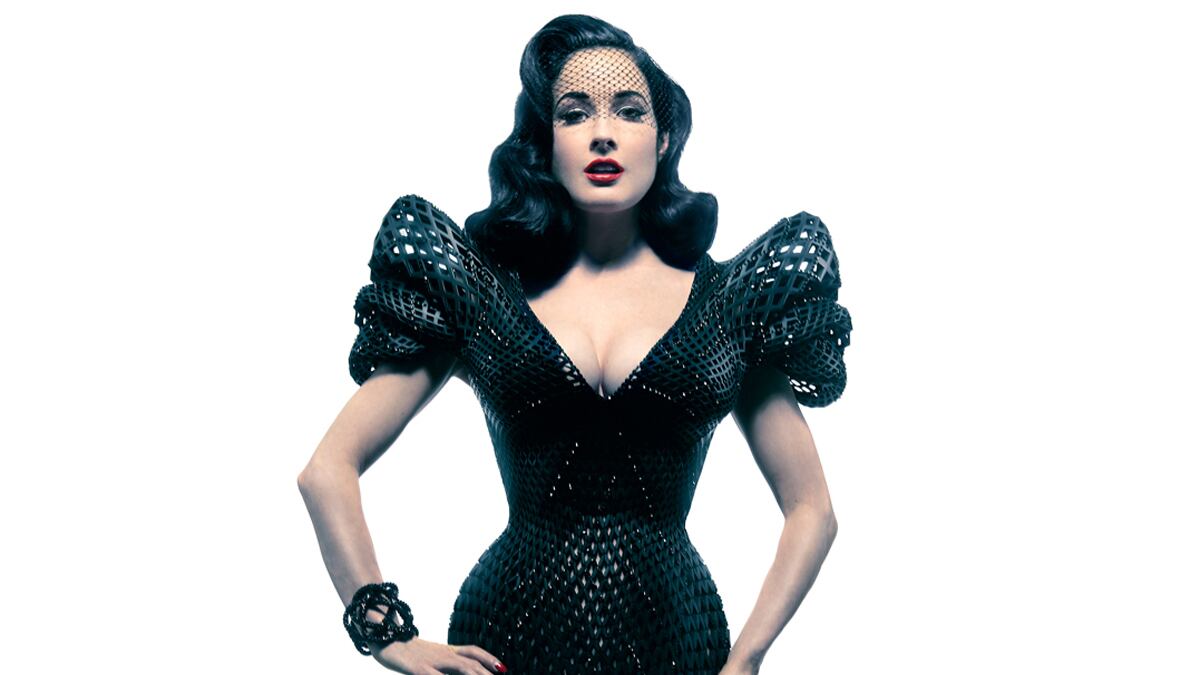
Fashion designer Michael Schmidt loves a good challenge. In his 30-year career designing specialty pieces for rock stars and musicians like Cher, Madonna, Tina Turner, Fergie, and Rihanna, he has taken great pride in working with difficult materials and making them wearable. The harder, the better.
“I like to adapt unusual materials to the body,” says Schmidt over lunch at Urth Caffé in downtown Los Angeles. “That’s kind of my thing, is to take things that are not typically utilized in clothing and try and make them wearable and flexible and danceable and sexy—meaning materials like metals, plastics, wood, glass. That’s the challenge for me, that’s what I enjoy doing is trying to figure those things out because it’s more of a mechanical, engineering problem.”
So when he was approached by the Ace Hotel to design a 3-D-printed dress for the hotel’s 3-D symposium during Fashion Week in March, he jumped at the chance—roping in his frequent collaborator and close friend, burlesque star Dita Von Teese.
Over the course of four months, Schmidt worked with New York–based architect Francis Bitonti to create a dress created entirely from a 3-D printer, a machine the size of a refrigerator. After Bitonti coded Schmidt’s vision, the dress was printed in 17 different sections containing over 3,000 pieces made from nylon using a process called selective laser sintering (SLS).
“It has a chamber,” Schmidt says of the printer. “And in the chamber there’s like a squeegee that lays down a layer of nylon powder, and a laser comes along and hardens segments into the design you want.”
When Von Teese wore the final product during Fashion Week, it immediately garnered a firestorm of attention, with coverage in The Huffington Post, Paper, and Forbes, among many others. And for the one of the first times in Schmidt’s career, he found himself on the front pages instead of behind the scenes. (Though he’s finally selling a jewelry line to the public—available at high-end boutiques like Maxfield—he’s long been under the radar in the fashion world.)
That bubble dress on Lady Gaga on the cover of Rolling Stone? His. Those Swarovski-crystal-covered shoulder pads worn by Madonna during the Sticky & Sweet tour? Pure Michael Schmidt. That crystal beaded chainmail dress Tina Turner shimmies in her Herb Ritts–photographed album cover? Also his design.
“Being in a hotel room with Tina Turner, alone, and having her try on your things and then launch suddenly into the famous Tina Turner dance moves—she’s, you know, da na na na na,” he says, doing her famous dance, and laughs at the recollection. “That may very well be my favorite memory of my entire career. That was pretty much it for me.”

Arianne Phillips, a two-time Oscar-nominated stylist who has worked with Schmidt on pieces for Madonna since 2001, counts herself as one of his biggest fans. “For a long time he was kind of the victim of being like everyone’s best-kept secret,” she says. “I’ve always been shouting his name from the rooftops. Michael has been the last to be self-promoting.”
Indeed as he eats lunch, Schmidt is the epitome of a low-key rock-and-roller. He wears a classic worn Bauhaus T-shirt, (we joke that’s he’s an “OG—an original goth”), black jeans, and a black cap covers his brown salt-and-peppered hair. He’s unflashy, but totally cool, right down to his 1971 black Camaro and his relaxed demeanor.
Born and bred in Kansas City, Missouri, Schmidt still seems like an easygoing Midwest guy, despite that he calls Cher and Deborah Harry good friends. “It’s nice having a Midwestern grounding,” he says.
Schmidt’s chill nature makes stars comfortable. They can trust him with their big secrets as he prepares costumes for their upcoming tours—as he did with Madonna’s recent MDNA circuit.
“He doesn’t have a force of ego. He’s just a like a down-home, salt-of-the-earth, good guy from the Midwest who happens to have outrageous ideas, incredible expertise and is best friends with some of the biggest icons from our culture,” says Phillips of Schmidt.
“I create and control so many aspects of my shows, my photos, my products, so it feels good to have the confidence in someone to just let go,” Von Teese tells The Daily Beast. “But there are very few people I have that kind of confidence in. Michael is one of them.”
“When I work with an entertainer, it’s not really about me,” says Schmidt. “It’s not as if I was doing a collection of clothing to put on a runway. It’s a collaborative experience, so you really are designing for a personality.”
The designer got his start after he moved to New York at 18 and started making jewelry out of found objects—“repurposed things that you find in like Canal Street,” he says. “I eventually found that I had a real passion for materials like metals and things and I started working in chainmail.”
His first break came when a dress of his was featured in the window of a SoHo store. Cher walked by and wanted to know who made it. Soon they were fast friends and collaborators.
“She would give my things away to her friends, like Bon Jovi and all these bands, and that’s how I started working with bands,” he says.
His work lends itself to rock and roll, in particular, and entertainment in general. Whether it’s a pair of metallic Daisy Dukes for Rihanna or a dress made of razor blades for Deborah Harry (which was shown at the Metropolitan Museum of Art), everything has a shiny, flashy edge.
“When working with rock stars and also these large stages, we love everything that sparkles, that’s photogenic and photographable,” says Phillips, who also praised the designer’s attention to detail: “He’s both a technician and an artist, which is an unusual combination.”
That geeky attention to detail came in handy with the 3-D dress. The challenge was to make it move and flow like fabric would—something that hadn’t really been done before. So far, most of what has been designed with 3-D printing has been solid and sculptural. The solution, said Schmidt and Bitonti, was to design thousands of intricately woven joints.
“It’s the first time a 3-D dress has ever been printed to have this ability to expand and contract around the body,” Schmidt says.
While man usually trumps machine—in this case, the machine achieved the unthinkable: “If I were to design each one of those joints by hand, it would have been impossible,” says Bitonti.
The resulting dress is “a fantasy,” as Schmidt calls it. With arched, undulating shoulders and a plunging neckline, the dress fit Von Teese like a glove, a result of Bitonti’s 3-D computerized image rendering.
“The shoulder is a solid form because I wanted to have a very Old World glamour, which is in keeping with Dita’s image,” says Schmidt. “It’s sort of an Adrianesque gown. Old Hollywood—that’s what the gown is like, but done in a very, very futuristic manner.”
And though there have been plenty of 3-D-printed fashions, most notably from Iris van Herpen, says Bitonti, “it’s the first time something like this has been put on a pop-culture icon, like Dita. This is the first time that I think it’s something that everybody can see this as a kind of reality and I think it being articulated and flexible and moving like fabric. I think it was a big breakthrough for the technology.”
Not even Schmidt was prepared for the reality of what it would look like, even after four months of working on it on Skype with Bitonti, who is based in New York. “They sent me video of it as it was coming out of the printer, and I was like, really, truly my mind was completely blown,” he says. “It was really exciting.”
Photos don’t do the dress justice. In person, the dress looks like a surrealist objet d’art—that sort of thing that Katniss should have been wearing in The Hunger Games. And though it looks heavy, it weighs only 11 pounds, which is like a feather for someone like Von Teese, who is used to wearing hefty gowns.
“I think the real message of this project is not about the actual wearability of this dress in everyday life, but about what the technology means when it is executed with creative people like Michael Schmidt,” Von Teese says. “It’s about taking those first steps into the future of fashion and thinking and understanding what the possibilities can be.”
“I’m always looking for innovative new materials,” Schmidt says. “There’s worlds of innovative things out there. And things that don’t have to necessarily be fabrics. I can make fabric out of anything,” he says, eyeing a wooden pole next to the table.
Even wood?
“Yeah. Have done,” he says in his relaxed drawl and smiles. “Whatever. Bring it on.”






